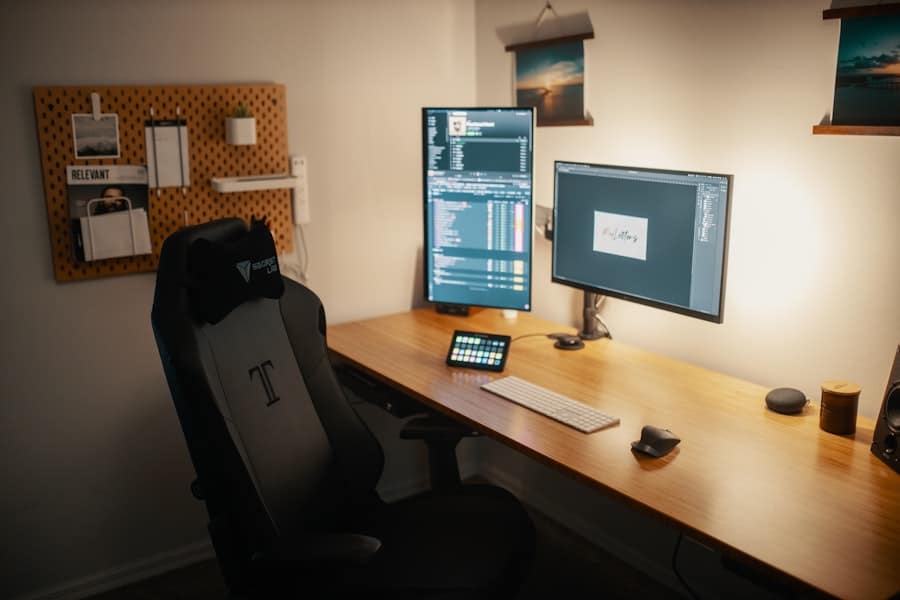The rise of remote work has transformed the traditional office landscape, leading to an increased focus on home office optimization. As more individuals transition to working from home, the need for a productive and efficient workspace has become paramount. Home office optimization involves creating an environment that enhances productivity, minimizes distractions, and leverages technology to streamline workflows.
This process encompasses various elements, including ergonomics, organization, and the integration of advanced technologies such as the Internet of Things (IoT). In this context, optimizing a home office is not merely about aesthetics or comfort; it is about creating a functional space that supports the unique demands of remote work. The integration of IoT technology plays a crucial role in this optimization process.
By connecting devices and systems within the home office, IoT can facilitate better communication, enhance productivity, and create a more efficient working environment. As we delve deeper into the intricacies of IoT technology and its applications in home office settings, it becomes evident that the future of remote work is closely tied to these advancements.
Key Takeaways
- Home office optimization is essential for maximizing productivity and efficiency in remote work environments.
- IoT technology refers to the interconnected network of devices that can communicate and exchange data, providing automation and control capabilities.
- Implementing IoT in home offices can lead to benefits such as improved energy efficiency, enhanced convenience, and streamlined workflows.
- IoT devices such as smart thermostats, lighting systems, and security cameras can contribute to the optimization of home office spaces.
- IoT can improve efficiency and productivity in home offices by automating routine tasks, providing real-time data insights, and enabling remote monitoring and control.
Understanding IoT (Internet of Things) Technology
The Internet of Things (IoT) refers to the network of interconnected devices that communicate and exchange data over the internet. This technology encompasses a wide range of devices, from smart home appliances to wearable technology, all designed to enhance user experience through automation and data analysis. At its core, IoT enables devices to collect and share information, allowing for real-time monitoring and control.
This interconnectedness is made possible through sensors, software, and other technologies that facilitate communication between devices. In a home office context, IoT technology can significantly enhance the way individuals interact with their work environment. For instance, smart thermostats can adjust the temperature based on occupancy or preferences, while smart lighting systems can change brightness levels according to the time of day or specific tasks.
The ability to control these devices remotely through smartphones or voice-activated assistants adds another layer of convenience and efficiency. Understanding the fundamental principles of IoT is essential for leveraging its potential in optimizing home office setups.
The Benefits of Implementing IoT in Home Offices

Implementing IoT technology in home offices offers numerous benefits that can lead to improved productivity and overall work satisfaction. One of the most significant advantages is automation. By automating routine tasks such as adjusting lighting or temperature, individuals can focus more on their work rather than managing their environment.
This not only saves time but also creates a more comfortable workspace that can adapt to changing needs throughout the day. Moreover, IoT devices can provide valuable insights into work habits and environmental conditions. For example, smart sensors can monitor air quality and suggest improvements if levels drop below optimal thresholds.
This data-driven approach allows individuals to make informed decisions about their workspace, leading to enhanced well-being and productivity. Additionally, the ability to integrate various devices into a cohesive system means that users can create customized workflows tailored to their specific needs, further enhancing efficiency.
IoT Devices for Home Office Optimization
A variety of IoT devices are available that can significantly enhance home office optimization. Smart speakers, such as Amazon Echo or Google Nest, serve as central hubs for controlling other smart devices through voice commands. These speakers can manage everything from lighting to scheduling meetings, allowing users to multitask effectively without interrupting their workflow.
Smart lighting systems are another essential component of an optimized home office. These systems can adjust brightness levels based on natural light availability or user preferences, reducing eye strain and creating a more conducive working environment. Additionally, smart plugs enable users to control non-smart devices remotely, allowing for greater flexibility in managing power consumption and device usage.
Another noteworthy category of IoT devices includes smart thermostats like Nest or Ecobee. These devices learn user preferences over time and can adjust heating or cooling automatically based on occupancy patterns. This not only enhances comfort but also contributes to energy savings—an important consideration for those working from home long-term.
How IoT Can Improve Efficiency and Productivity
The integration of IoT technology into home offices can lead to significant improvements in efficiency and productivity. One way this occurs is through enhanced time management capabilities. For instance, smart calendars can sync with various devices to provide reminders and alerts for upcoming meetings or deadlines.
This ensures that individuals remain organized and focused on their tasks without the risk of overlooking important commitments.
Tools like smart video conferencing systems allow for high-quality virtual meetings with features such as screen sharing and real-time collaboration on documents.
This fosters a sense of connection among team members, which is crucial for maintaining morale and productivity in a remote work environment. Additionally, IoT technology can help reduce distractions by automating certain aspects of the work environment. For example, smart noise-canceling devices can create a quieter atmosphere by filtering out background noise, allowing individuals to concentrate better on their tasks.
By minimizing interruptions and streamlining workflows, IoT contributes to a more productive home office experience.
Security and Privacy Considerations for IoT in Home Offices

While the benefits of implementing IoT technology in home offices are substantial, it is essential to address security and privacy concerns associated with these devices. The interconnected nature of IoT means that vulnerabilities in one device can potentially compromise the entire network. Cybersecurity threats such as hacking or unauthorized access are significant risks that users must consider when integrating IoT into their home offices.
To mitigate these risks, it is crucial to implement robust security measures. This includes regularly updating device firmware to patch vulnerabilities, using strong passwords for all connected devices, and enabling two-factor authentication where possible. Additionally, creating a separate network for IoT devices can help isolate them from personal computers and sensitive information.
Privacy is another critical consideration when using IoT technology in home offices. Many smart devices collect data about user behavior and preferences, which raises concerns about how this information is stored and used. Users should familiarize themselves with privacy policies associated with their devices and take steps to limit data sharing where possible.
By being proactive about security and privacy, individuals can enjoy the benefits of IoT while minimizing potential risks.
Integrating IoT with Existing Home Office Setups
Integrating IoT technology into existing home office setups requires careful planning and consideration of current workflows and equipment. The first step is to assess which areas of the workspace could benefit from automation or connectivity. For instance, if lighting is an issue during certain times of the day, investing in smart lighting solutions may be a priority.
Once potential improvements have been identified, users should consider compatibility with existing devices. Many IoT products are designed to work seamlessly with popular platforms like Google Assistant or Amazon Alexa, making integration relatively straightforward. However, it is essential to ensure that new devices can communicate effectively with current systems to avoid complications.
Additionally, creating a centralized control system can enhance usability and streamline operations within the home office. This could involve using a dedicated app or platform that allows users to manage all connected devices from one location. By taking these steps toward integration, individuals can create a cohesive and efficient workspace that leverages the full potential of IoT technology.
Future Trends and Developments in IoT for Home Office Optimization
As technology continues to evolve, so too will the applications of IoT in home office optimization. One emerging trend is the increased use of artificial intelligence (AI) in conjunction with IoT devices. AI algorithms can analyze data collected from various sensors to provide personalized recommendations for optimizing work environments based on individual preferences and habits.
Another significant development is the growing emphasis on sustainability within home office setups. As awareness of environmental issues increases, more consumers are seeking energy-efficient solutions that reduce their carbon footprint. Future IoT devices may incorporate advanced energy management features that optimize power consumption based on real-time usage patterns.
Moreover, advancements in connectivity technologies such as 5G will further enhance the capabilities of IoT devices in home offices. With faster data transfer speeds and lower latency, users will be able to connect multiple devices seamlessly without experiencing lag or connectivity issues. This will enable even more sophisticated automation and integration possibilities.
In conclusion, the future of home office optimization through IoT technology holds immense potential for enhancing productivity, efficiency, and overall work satisfaction. As individuals continue to adapt to remote work environments, embracing these advancements will be crucial for creating effective and sustainable home office setups.
In the realm of optimizing home offices, the Internet of Things (IoT) plays a pivotal role by seamlessly integrating various smart devices to enhance productivity and comfort. A related article that delves into the technological advancements in personal devices is How to Choose the Right iPhone for You in 2023. This article provides insights into selecting the most suitable iPhone, which can be an essential tool in a smart home office setup, offering features that complement IoT devices for improved efficiency and connectivity.
FAQs
What is IoT?
IoT stands for Internet of Things, which refers to the network of physical devices, vehicles, home appliances, and other items embedded with electronics, software, sensors, actuators, and connectivity which enables these things to connect and exchange data.
How does IoT optimize home offices?
IoT can optimize home offices by providing smart devices and systems that can automate tasks, improve energy efficiency, enhance security, and streamline communication and collaboration.
What are some examples of IoT devices for home office optimization?
Examples of IoT devices for home office optimization include smart thermostats, smart lighting, smart security cameras, smart locks, smart plugs, and smart speakers.
How does IoT improve energy efficiency in home offices?
IoT devices can improve energy efficiency in home offices by automatically adjusting heating, cooling, and lighting based on occupancy and usage patterns, as well as providing insights into energy consumption for better management.
How does IoT enhance security in home offices?
IoT enhances security in home offices by providing remote monitoring and control of security cameras, smart locks, and sensors, as well as enabling alerts and notifications for potential security threats.
How does IoT streamline communication and collaboration in home offices?
IoT streamlines communication and collaboration in home offices by enabling seamless integration of communication tools, scheduling, and task management, as well as providing remote access to files and documents.

